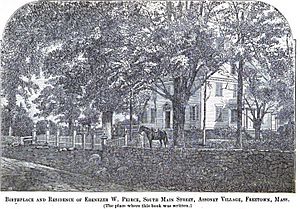Ebenezer W. Peirce facts for kids
Quick facts for kids
Ebenezer W. Peirce
|
|
|---|---|

Ebenezer W. Peirce
|
|
| Born | April 10, 1822 Assonet, Massachusetts |
| Died | August 14, 1902 (aged 80) Assonet, Massachusetts |
| Buried |
Assonet Burying Ground
|
| Allegiance | Union |
| Service/ |
Union Army |
| Years of service | 1843 - 1864 |
| Rank | |
| Battles/wars | American Civil War |
| Other work | Farmer |
| Signature | |
Ebenezer Weaver Peirce (born April 10, 1822 – died August 14, 1902) was an important military leader from Massachusetts. He served as a brigadier general in the Massachusetts militia. When the American Civil War began, he volunteered for the Union Army. He later became a colonel, leading the 29th Massachusetts Volunteer Infantry Regiment. After his military career, he worked as a farmer, bought and sold land, and became a historian and expert on family histories.
Contents
Early Life and Military Start
Ebenezer Peirce was born in Assonet, Massachusetts. His parents were Ebenezer and Joanna (Weaver) Peirce. He went to local schools in Assonet and later attended Phillips Academy in Andover.
He inherited a lot of land and started a sheep farm. In 1843, Peirce joined the 4th Artillery, Massachusetts Volunteer Militia. He continued to serve in the military right up to the Civil War.
Service in the Civil War
In 1861, Peirce was a brigadier general in the Massachusetts State Militia. He worked under Major General Benjamin F. Butler at Fort Monroe in Virginia.
Battle of Big Bethel
Peirce was in charge of Union forces at the Battle of Big Bethel in June 1861. This was an early battle in the war. The Union plan was to attack two Confederate positions. However, the unit was largely untrained. They accidentally fired on their own troops, which gave away their position. The attack failed, and Peirce received much of the blame.
Leading the 29th Massachusetts Infantry
On December 13, 1861, Peirce joined the volunteer forces. He became a colonel and led the 29th Massachusetts Infantry Regiment. His regiment was stationed at Fort Monroe. They were involved in the battle of Hampton Roads, a famous naval battle.
Peirce faced a military hearing but was found not guilty. He then fought in the Peninsula Campaign. This was a major Union effort to capture the Confederate capital of Richmond.
Wounded in Battle
During the Seven Days Battles, on June 30, 1862, Peirce was badly wounded. He lost his right arm at the Battle of White Oak Swamp. This battle was part of the larger Battle of Glendale.
He was out of action for several months. In November 1862, he returned to command his regiment. He then served in the siege of Knoxville. His regiment later returned to Virginia. They fought at Battle of Cold Harbor and the Second Battle of Petersburg.
Peirce commanded a brigade during several periods in 1863 and 1864. He was discharged from the military on November 4, 1864. This was because of the loss of his arm and health issues. He then returned home to Assonet. In 1880, he served for one year on the Freetown Board of Selectmen, helping to manage the town.
Later Life and Family
Ebenezer Peirce married Irene I. Payne on December 13, 1849. They had one son who lived past childhood, named Palo Alto Peirce. Palo Alto later became the town clerk of Freetown for many years.
Peirce was elected a life member of the Old Colony Historical Society in 1855. He also became a resident member in 1886. On April 5, 1892, Ebenezer Peirce married Ida E. Gardner. She was a graduate of the Bridgewater Normal School.
Ebenezer Peirce passed away on August 14, 1902, at the age of 80. He is buried in the Assonet Burying Ground.
Legacy and Writings
In 1867, a group called the E. W. Peirce Encampment, Post 8, Grand Army of the Republic was formed in Middleborough, Massachusetts. It was named in honor of Ebenezer W. Peirce.
Peirce was also a writer. He wrote many books and articles about history in Bristol and Plymouth counties. One of his notable books was Indian History, Biography and Genealogy. This book was about the good Sachem Massasoit of the Wampanoag Tribe and his family. It was published in 1878 by Zerviah Gould Mitchell, who was a descendant of Massasoit.
See also
 In Spanish: Ebenezer Peirce para niños
In Spanish: Ebenezer Peirce para niños


